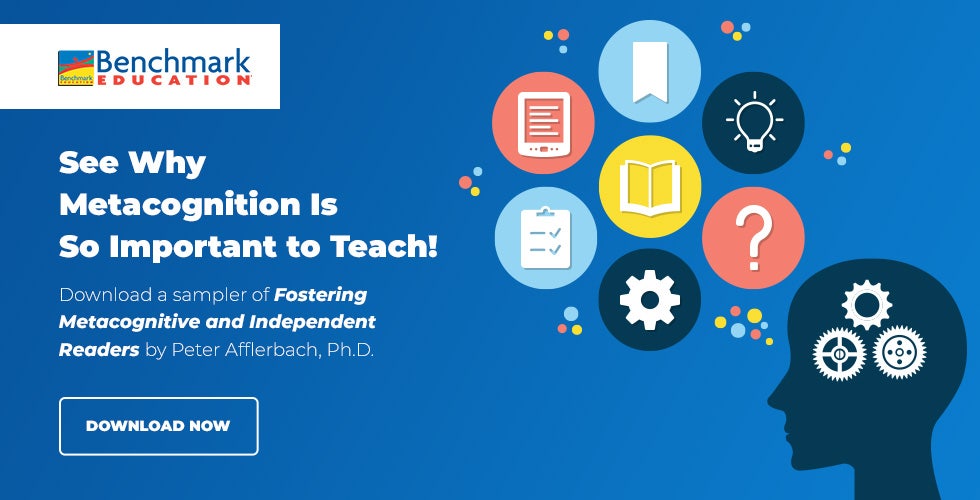- Benchmark Education
- Newmark Learning
- Reycraft Books
- Create an Account
Teaching Metacognitive Strategies in the Classroom

At its simplest, metacognition is thinking about our thinking. In the classroom, metacognition allows students to move from learning to read to reading to learn. When they are stuck or reading breaks down, metacognition helps readers understand what help they need and what fix-up strategies can help. It supports deeper comprehension, critical thinking and analysis, and skillful, mature reading. Metacognition is just as foundational to independent reading as the foundational skills that support the mechanical aspects of reading.
Teaching metacognitive strategies in the classroom helps students to become more strategic and to think like readers. In addition to using such metacognitive comprehension strategies as questioning, visualizing, and synthesizing information, metacognitive readers plan their reading, set goals, and monitor their progress.
Why Teach Metacognitive Strategies?
Most students don’t come to school aware of metacognition. It must be taught explicitly, like so many things, so that kids come to recognize and listen to their inner reading voice. Students receive three crucial benefits when we teach metacognition:
- The ability to synthesize foundational reading skills and go from learning to read to reading to learn
- Deeper comprehension, which leads to knowledge building, including the ability to fix up their reading on the spot
- Greater control over their reading and increased independence, including stamina, motivation and engagement, goal-setting, and more
What does teaching metacognition lead to?
- Success acquiring and applying new ideas and concepts in all content areas
- Transferable skills that support college and career readiness
- A lifelong love of reading
Teaching cognitive and metacognitive strategies ultimately creates the opportunity for students to use these strategies far beyond school and well into their adult lives.
Synthesis of Foundational Reading Skills
Foundational skills allow students to become fluent, but because they are mechanical and technical in nature, they don’t fully support children’s ability to make meaning. Without metacognition, many students become “word callers” who can read orally with fluency, but who don’t have comprehension. Metacognitive readers knit together the strands of Scarborough’s Reading Rope as they generate meaning.
Deeper Comprehension
In addition to fusing together decoding and vocabulary acquisition, metacognitive readers also develop the ability to monitor their reading. They use comprehension strategies such as inferring or determining importance flexibly to fix up comprehension on the fly. At a deeper level, they can also approach difficult texts with other types of strategies such as slowing down their reading, consulting outside sources (e.g., dictionaries, Google), rereading, and a host of other highly strategic actions. They go beyond the commonly taught comprehension strategies to make deeper meaning and connections with less instructional support.
Greater Control Over Reading and Increased Independence
These run hand in hand. We want all students to exhibit control over their reading. As skilled readers, we know that the ability to focus on and attend to text is crucial to our success. This ability is related to areas such as executive functioning, motivation and engagement, and our self-perception as readers. Without these invisible traits, students struggle to move through texts, create and stick to plans for reading, and develop stamina as readers—all of which are foundational to college and career readiness.
How to Teach Metacognition: A Three-Part Process
Teaching metacognitive skills gives students a three-part process that helps them think like readers:
- Develop a plan before beginning to read a text
- Monitor their own understanding of the text and use strategies to correct when meaning breaks down
- Evaluate their thinking once the reading is finished
Whole-group and small-group activities give students the opportunities they need to carry out all three of these tasks. In both settings, teachers can explicitly show students how metacognition works with think-alouds, then provide time for guided and independent practice.
Develop a Plan Before Beginning to Read
An effective way to teach students how to plan is through modeling and practice. Plans that students can make may include:
- Thinking about the topic at hand
- Reading the title, author, front and/or back covers, and table of contents
- Studying photos, graphics, and illustrations
- Skimming for headings, sub-headings, boldfaced words, and summaries
- Thinking about the information they know and what connections they can make
- Thinking about what questions they have
- Considering structures like compare/contrast, sequence of events, and cause/effect
In addition, students can learn to think about problems in the text and solutions, descriptions, and a combination of any of the above text structures.
Monitoring Their Understanding and Strategizing
During reading, students must learn to monitor their own comprehension. Recognizing whether confusion exists is the first step. There are a variety of reasons why readers can become confused during reading. Some of the reasons for confusion can include:
- A reader’s mind starts to wander until they are no longer paying attention
- A reader can’t remember something they read
- A reader is unable to answer their own questions about the text
- A student re-encounters a character but doesn’t remember anything about meeting the character in the story previously
Metacognitive instruction helps students recognize confusion and respond strategically and independently.
Evaluating Their Thinking Once Reading Is Finished
Students who are good readers reflect on the strategies they used to determine whether the plan they created worked. If so, they can try the same plan again next time. If not, they should realize that they need to try something else.
Evaluating their own thinking is critical to the development of metacognitive processes. Educators must practice evaluation regularly with their students—especially young students in elementary grades.
Metacognitive Processes Beyond the Classroom
Metacognition is the secret sauce of reading and learning. In skilled, mature readers, it is always behind the scenes working to link prior to new knowledge and to support understanding. Metacognition is even with us when we read for pleasure. When we ask questions such as “What will this character do?!” and we are driven to turn the page of our latest novel, it is because metacognition is doing its job. Explicit instruction in metacognition is a gift we can give the students in our classrooms that will improve not only their school lives or their reading lives but their lives in entirety.
For more, read a sample from our PD Essentials book Fostering Metacognitive and Independent Readers.
Resources:
- https://teaching.cornell.edu/teaching-resources/teaching-cornell-guide/teaching-strategies/metacognitive-strategies-how-people
- Fogarty, R. (1994). How to Teach for Metacognition. Palatine, IL: IRI/Skylight Publishing.
- Wilhelm, J.(2001) Improving Comprehension with Think-Aloud Strategies. New York, NY: Scholastic Professional Books
- Tovani, C. (2000) I Read It, But I Don’t Get It. Portland, ME: Stenhouse Publishers

















